Livestock Analysis | September 21, 2022

Price action: October lean hog futures fell $1.55 to $94.425, the contract’s lowest closing price since Sept. 12, while December hogs fell $1.725 to $86.45.
Fundamental analysis: Hog futures fell to the lowest levels in over a week as the market extended Tuesday’s weakness on signs of further erosion in cash fundamentals. The CME lean hog index fell 6 cents to $98.36 (as of Sept. 19) and is expected to drop another 40 cents Thursday. Pork cutout values fell $4.58 early today to $100.37, as a tumble of over $18 in bellies led the prices to the lowest level since early February. December futures ended nearly $8 lower than nearby October, indicating traders expect a seasonal increase in supplies and slaughter to weigh on hog prices in coming weeks, with USDA’s quarterly Hogs and Pigs report Sept. 29 likely to be one key to market direction this fall.
Technical analysis: Lean hog technicals took a bearish turn as October futures settled below 40- and 50-day moving averages around $95.15 and $95.00, respectively. Market bulls will need to defend key support at 100- and 20-day moving averages around $93.55 and $93.05, respectively, to avoid further slippage toward the September low at $89.125. Initial resistance is pegged at the 40- and 50-day moving averages and at Tuesday’s high of $97.45, a five-week high.
What to do: Be prepared to extend feed coverage when market bottoms are in place.
Hedgers: Carry all risk in the cash market for now.
Feed needs: You are hand-to-mouth on corn-for-feed and soybean meal needs.
Price action: October live cattle fell 42.5 cents to $145.875. October feeder futures fell 80 cents to $179.225.
Fundamental analysis: Slumping wholesale beef and a surging U.S. dollar weighed on live cattle futures, overshadowing prospects for continued strength in the cash market. Choice cutout values fell $1.57 early today to $250.07, the lowest daily average since April 2021. Still, tight supplies of market-ready fed cattle may drive a seasonal advance in the weeks ahead. Meanwhile, expectations for another Federal Reserve interest rate increase sent the U.S. dollar index surging to a fresh 20-year high. The Fed’s aggressive moves to tamp down inflation suggests the dollar index could test its 2001 highs around 121.00 in the coming weeks, which may hamper U.S. meat exports. Rising interest rates could also trigger recession, although that shouldn’t hurt domestic demand since consumers tend to curtail restaurant visits and buy more at the grocery store in such conditions.
The short-term feeder cattle outlook seems less than promising due to tighter U.S. corn and soybean supplies and rising feed costs. Many producers in the Southwest may be forced to reduce or liquidate herds this fall due to a severe shortage of water and grass, which portends increased supplies of calves and yearlings coming onto the market in the short run. Conversely, that will almost surely exacerbate the growing cyclical shortage of cattle. That’s a formula for surging feeder prices next year.
Technical analysis: Bulls still hold a short-term technical advantage in live cattle after October futures reached a five-month high Tuesday. Today’s low puts initial support for October futures at $145.75, with backing from the contract’s 10-, 20- and 40-day moving averages near $145.39, $144.52 and $144.22, respectively. Today’s high marks initial resistance at $145.475, with backing from yesterday’s high of $146.775. A push above that point would have bulls targeting the April contract high of $147.50, then the psychological $150.00 level.
Bears clearly hold the short-term technical advantage in October feeder futures after today’s drop. It closed just above initial support at the daily low of $178.675, with a drop below that point likely having bears targeting the July low of $176.25, then the psychological $175.00 level. Look for initial resistance around the psychological $180.00 level, with today’s high marking secondary resistance at $181.35. A push above that point would have bulls targeting the 40-day moving average at $184.46.
What to do: Be prepared to extend feed coverage when market bottoms are in place.
Hedgers: Carry all risk in the cash market for now.
Feed needs: You are hand-to-mouth on corn-for-feed and soybean meal needs.






